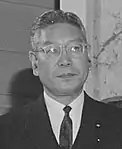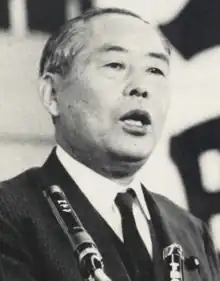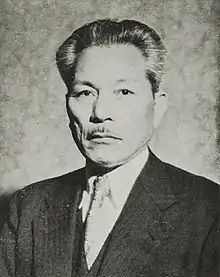| |||||||||||||||||||||||||||||||||||||||||||||||||||||||||||||||||||||
127 of the 250 seats in the House of Councillors 126 seats needed for a majority | |||||||||||||||||||||||||||||||||||||||||||||||||||||||||||||||||||||
|---|---|---|---|---|---|---|---|---|---|---|---|---|---|---|---|---|---|---|---|---|---|---|---|---|---|---|---|---|---|---|---|---|---|---|---|---|---|---|---|---|---|---|---|---|---|---|---|---|---|---|---|---|---|---|---|---|---|---|---|---|---|---|---|---|---|---|---|---|---|
| |||||||||||||||||||||||||||||||||||||||||||||||||||||||||||||||||||||
| |||||||||||||||||||||||||||||||||||||||||||||||||||||||||||||||||||||
| This article is part of a series on |
| Politics of Japan |
|---|
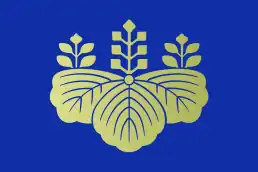 |
|
|
House of Councillors elections were held in Japan on 1 July 1962,[1] electing half the seats in the House. The Liberal Democratic Party won the most seats. This was the first Japanese national election to feature the Kōmeitō as a candidate, as it had formed earlier in the same year.
As is typical for House of Councillors elections, candidate personality and public appeal played a stronger role than they would in a House of Representatives election; the first place winner for the national district voting was Aki Fujiwara, a panelist on the Japanese version of I've Got a Secret, who broke all of the previous House of Councillors records by obtaining 1,160,000 votes.[2]
The Japan Socialist Party (JSP) had attempted to make questions of constitutional revision the main issue for the election, whereas the LDP attempted to sideline the issue by claiming that it would not pursue any constitutional amendments unless it were to receive recommendations from the Constitutional Investigation Commission, which was still in the process of deliberating at the time of the election. Overall, the JSP lost the most in this election, losing 19 seats, whereas the LDP gained 10 seats.[2]
Results
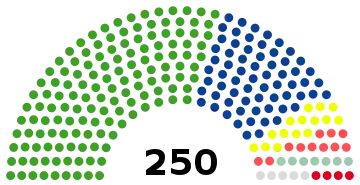 | ||||||||||||
|---|---|---|---|---|---|---|---|---|---|---|---|---|
| Party | National | Constituency | Seats | |||||||||
| Votes | % | Seats | Votes | % | Seats | Not up | Won | Total after | +/– | |||
| Liberal Democratic Party | 16,581,637 | 46.37 | 21 | 17,112,986 | 47.13 | 48 | 73 | 69 | 142 | +10 | ||
| Japan Socialist Party | 8,666,910 | 24.24 | 15 | 11,917,675 | 32.82 | 22 | 29 | 37 | 66 | –19 | ||
| Kōmeitō | 4,124,269 | 11.53 | 7 | 958,179 | 2.64 | 2 | 6 | 9 | 15 | New | ||
| Democratic Socialist Party | 1,899,756 | 5.31 | 3 | 2,649,422 | 7.30 | 1 | 7 | 4 | 11 | New | ||
| Dōshikai | 1,660,466 | 4.64 | 2 | 128,834 | 0.35 | 0 | 5 | 2 | 7 | New | ||
| Japanese Communist Party | 1,123,947 | 3.14 | 2 | 1,760,258 | 4.85 | 1 | 1 | 3 | 4 | +1 | ||
| Other parties | 295,603 | 0.83 | 0 | 58,622 | 0.16 | 0 | 0 | 0 | 0 | 0 | ||
| Independents | 1,404,048 | 3.93 | 1 | 1,725,947 | 4.75 | 2 | 2 | 3 | 5 | –13 | ||
| Total | 35,756,636 | 100.00 | 51 | 36,311,923 | 100.00 | 76 | 123 | 127 | 250 | 0 | ||
| Valid votes | 35,756,636 | 93.38 | 36,311,923 | 94.82 | ||||||||
| Invalid/blank votes | 2,534,276 | 6.62 | 1,983,299 | 5.18 | ||||||||
| Total votes | 38,290,912 | 100.00 | 38,295,222 | 100.00 | ||||||||
| Registered voters/turnout | 56,137,295 | 68.21 | 56,137,295 | 68.22 | ||||||||
| Source: Ministry of Internal Affairs and Communications,[1][3] National Diet | ||||||||||||
By constituency
| Prefecture | Total seats |
Seats won | ||||||
|---|---|---|---|---|---|---|---|---|
| LDP | JSP | Kōmeitō | DSP | JCP | Dōshikai | Ind. | ||
| Aichi | 3 | 2 | 1 | |||||
| Akita | 1 | 1 | ||||||
| Aomori | 1 | 1 | ||||||
| Chiba | 2 | 1 | 1 | |||||
| Ehime | 1 | 1 | ||||||
| Fukui | 1 | 1 | ||||||
| Fukuoka | 3 | 2 | 1 | |||||
| Fukushima | 2 | 1 | 1 | |||||
| Gifu | 1 | 1 | ||||||
| Gunma | 2 | 1 | 1 | |||||
| Hiroshima | 2 | 1 | 1 | |||||
| Hokkaido | 4 | 1 | 2 | 1 | ||||
| Hyōgo | 3 | 2 | 1 | |||||
| Ibaraki | 2 | 1 | 1 | |||||
| Ishikawa | 1 | 1 | ||||||
| Iwate | 1 | 1 | ||||||
| Kagawa | 1 | 1 | ||||||
| Kagoshima | 2 | 1 | 1 | |||||
| Kanagawa | 2 | 1 | 1 | |||||
| Kōchi | 1 | 1 | ||||||
| Kumamoto | 2 | 2 | ||||||
| Kyoto | 2 | 1 | 1 | |||||
| Mie | 1 | 1 | ||||||
| Miyagi | 1 | 1 | ||||||
| Miyazaki | 1 | 1 | ||||||
| Nagano | 2 | 1 | 1 | |||||
| Nagasaki | 1 | 1 | ||||||
| Nara | 1 | 1 | ||||||
| Niigata | 2 | 1 | 1 | |||||
| Ōita | 1 | 1 | ||||||
| Okayama | 2 | 1 | 1 | |||||
| Osaka | 3 | 1 | 1 | 1 | ||||
| Saga | 1 | 1 | ||||||
| Saitama | 2 | 1 | 1 | |||||
| Shiga | 1 | 1 | ||||||
| Shimane | 1 | 1 | ||||||
| Shizuoka | 2 | 2 | ||||||
| Tochigi | 2 | 1 | 1 | |||||
| Tokushima | 1 | 1 | ||||||
| Tokyo | 5 | 2 | 1 | 1 | 1 | |||
| Tottori | 1 | 1 | ||||||
| Toyama | 1 | 1 | ||||||
| Wakayama | 1 | 1 | ||||||
| Yamagata | 1 | 1 | ||||||
| Yamaguchi | 1 | 1 | ||||||
| Yamanashi | 1 | 1 | ||||||
| National | 51 | 21 | 15 | 7 | 3 | 2 | 2 | 1 |
| Total | 127 | 69 | 37 | 9 | 4 | 3 | 2 | 3 |
References
- 1 2 Table 13: Persons Elected and Votes Polled by Political Parties - Ordinary Elections for the House of Councillors (1947–2004) Archived 2011-03-23 at the Wayback Machine Ministry of Internal Affairs and Communications
- 1 2 Ukai, Nobushige (1962). "The Japanese House of Councillors Election of July 1962". Asian Survey. 2 (6): 1–8. doi:10.2307/3023612. ISSN 0004-4687.
- ↑ "27-11 Allotted Number, Candidates, Eligible Voters as of Election Day, Voters and Voting Percentages of Ordinary Elections for the House of Councillors (1947-2004)". Ministry of Internal Affairs and Communications. Archived from the original on 2006-01-04.
